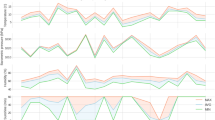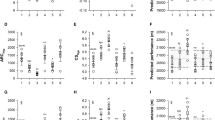Abstract
The effects of air temperature, relative and specific humidity, wind speed, solar shortwave radiation, thermal longwave radiation, and rain on the performance of participants in the annual Stockholm Marathon from 1980 to 2008 were analysed statistically. The objective was to validate and extend previous studies by including data on finishing times of slower male and female runners and on the percentage of non-finishers. Due to decadal trends in the finishing time not related to weather, the finishing time anomaly (FTA) was calculated as the deviation of the annual finishing time from the linear trend of the finishing time. In all categories of runners, the single weather parameter with highest correlation with the FTA was the air temperature (correlation coefficient r = 0.66–0.73, with the highest values for slowest runners). Also, the solar shortwave radiation (r = 0.41–0.71), air relative humidity (r = −0.57 to −0.44) and, for male runners, the occurrence of rain (r = −0.51 to −0.42) reached a statistically significant correlation with the FTA, but the effects of the relative humidity and rain only arose from their negative correlation with the air temperature. The percentage of non-finishers (PNF) was significantly affected by the air temperature and specific humidity (r = 0.72 for multiple regression), which is a new result. Compared to faster runners, the results of slower runners were more affected by unfavourable weather conditions; this was previously known for runners with finishing times of 2.1–3 h, and now extended to finishing times of 4.7 h. Effects of warm weather were less evident for female than male runners, which was probably partly due to female runners’ larger ratio of surface area to body mass and slower running speed.





Similar content being viewed by others
References
Bouoncristiani JF, Martin DE (1983) Factors affecting runners’ marathon performance. Chance 6:24–30
Cheuvront SN, Haymes EM (2001) Thermoregulation and marathon running: biological and environmental influences. Sports Med 31:743–762
Cheuvront SN, Carter R III, DeRuisseau KC, Moffatt RJ (2005) Running performance differences between men and women. Sports Med 35:1017–1024
De Freitas CR, Dawson NJ, Young AA, Mackey WJ (1985) Microclimate and heat stress of runners in mass participation events. J Clim Appl Meteorol 24:184–191
Dennis SC, Noakes TD (1999) Advantages of a smaller bodymass in humans when distance-running in warm, humid conditions. Eur J Appl Physiol 79:280–284
Ely MR, Cheuvront SN, Roberts WO, Montain SJ (2007a) Impact of weather on marathon running performance. Med Sci Sports Exerc 39:487–493
Ely MR, Cheuvront SN, Montain SJ (2007b) Neither cloud cover nor low solar loads are associated with fast marathon performance. Med Sci Sports Exerc 39:2029–2035
Ely MR, Martin DE, Cheuvront SN, Montain SJ (2008) Effect of ambient temperature on marathon pacing is dependent on runner ability. Med Sci Sports Exerc 40:1675–1680
Havenith G (2001) Individualized model of human thermoregulation for the simulation of heat stress response. J Appl Physiol 90:1943–1954
Haymes EM (1984) Physiological responses of female athletes to heat stress: a review. Phys Sports Med 12:45–49
Lind AR (1963) A physiological criterion for setting thermal environmental limits for everyday work. J Appl Physiol 18:51–56
Nielsen B (1996) Olympics in Atlanta: as fight against physics. Med Sci Sports Exerc 28:665–668
Noakes TD (2007) Reduced peripheral resistance and other factors in marathon collapse. Sports Med 37:382–385
Roberts WO (2000) A 12-yr profile of medical injury and illness for the Twin Cities Marathon. Med Sci Sports Exerc 32:1549–1555
Trapasso LM, Cooper JD (1989) Record performances at the Boston Marathon: biometeorological factors. Int J Biometeorol 33:233–237
Tucker R, Marle T, Lambert EV, Noakes TD (2006) The rate of heat storage mediates an anticipatory reduction in exercise intensity during cycling at a fixed rating of perceived exertion. J Physiol 574:905–915
Verdaguer-Godina J, Martin DE, Pujol-Amat P (1995) Climatic heat stress studies at the Barcelona Olympic Games, 1992. Sports Med Train Rehabil 6:167–192
Wright A, Marino FE, Micalos P, Kay D, Fanning C, Cannon J, Noakes TD (2002) Influence of lean body mass on performance differences of male and female distance runners in warm humid environments. Am J Phys Anthropol 118:285–291
Zhang S, Guanglin M, Yanwen W, Ji L (1992) Study on the relationships between weather conditions and the marathon race, and of meteorological effects on distance runners. Int J Biometeorol 36:63–68
Acknowledgments
I thank two anonymous reviewers as well as Yrjö Vihma and David Schultz for their constructive comments.
Author information
Authors and Affiliations
Corresponding author
Rights and permissions
About this article
Cite this article
Vihma, T. Effects of weather on the performance of marathon runners. Int J Biometeorol 54, 297–306 (2010). https://doi.org/10.1007/s00484-009-0280-x
Received:
Revised:
Accepted:
Published:
Issue Date:
DOI: https://doi.org/10.1007/s00484-009-0280-x




